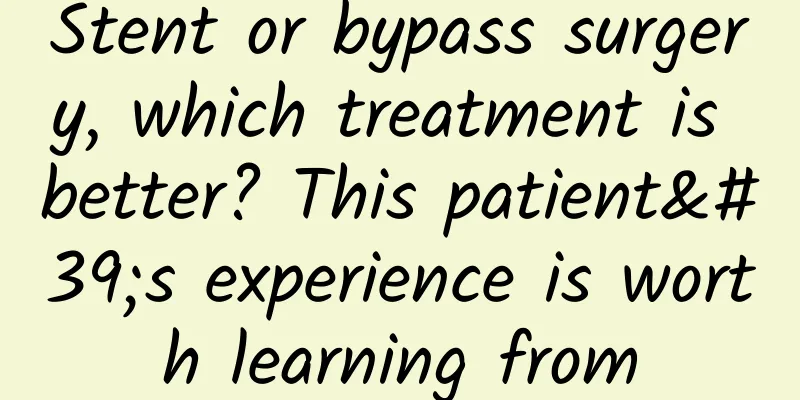Stent or bypass surgery, which treatment is better? This patient's experience is worth learning from

|
The patient was "very dissatisfied" with the doctor's treatment plan: This is a 60-year-old man who was treated in a local hospital for a large-area myocardial infarction half a month ago. During his hospitalization, he suddenly suffered from severe heart failure. Cardiac ultrasound revealed that his heart valve was not fully closed, resulting in a large amount of reflux, so he was transferred to a higher-level hospital. After active drug treatment, the patient's heart failure and myocardial infarction symptoms improved significantly, but the follow-up ultrasound showed that the valvular regurgitation had not improved. The doctor performed a cardiac angiography on the patient: two main blood vessels were severely narrowed. The patient thought that after the angiography, the stent could be placed, but the doctor recommended a surgical thoracotomy bypass. Patients are very confused: When they have cardiovascular stenosis, why don’t doctors recommend stents that are less invasive, but instead ask patients to undergo “laparotomy” for bypass surgery? This is because stents and bypass surgery are suitable for different groups of people, and their advantages and disadvantages are also very different. 1. Advantages of the stent Stenting is a minimally invasive internal medicine surgery that only requires local anesthesia at the arterial puncture site. It causes little trauma, less pain, and quick recovery. The patient does not need to be bedridden for a long time due to the surgery, so the hospitalization time is short. The physical requirements and financial burden on patients are relatively low. 2. Limitations of stents The biggest problem with stents is restenosis, which means the stent is blocked again. With the improvement of oral antiplatelet drugs and stent manufacturing technology, the incidence of restenosis in stents has been significantly reduced, but there are many reasons for stenosis, such as damage to the blood vessel wall caused by stent implantation, and the growth of endothelial cells into the stent and the formation of atherosclerosis, which cannot be completely overcome. Therefore, it is only a matter of time before the stent restenosis occurs. Moreover, the more stents are implanted, the higher the probability of restenosis or even blockage. For example, in cases of multi-vessel diffuse cardiovascular disease, many stents may be needed, which greatly increases the risk of restenosis, and the long-term effect and safety of the operation are not as good as those of surgical bypass. Disadvantages of bridging Bypass is a surgical thoracotomy that must be performed under general anesthesia. This surgery is very traumatic and requires sawing open the sternum or stretching the ribs to expose the heart and aorta. Patients with poor physical conditions may even need to stay in the ICU on a ventilator for a period of time, which slows their recovery and requires longer hospitalization. 4. Advantages of Bridging For some complex coronary artery lesions, bypass surgery can make up for the shortcomings of stents. For example, in left main artery lesions, if the stent is blocked during or after surgery, it will cause fatal damage; if many stents are implanted in diffuse three-vessel lesions, the chance of restenosis will increase greatly. Therefore, bypass surgery is a more appropriate surgical method. In addition, if coronary heart disease causes complications such as heart rupture, ventricular septal perforation, and valvular insufficiency, surgical bypass surgery must be chosen, because at this time not only the blood vessels must be opened, but the complications must also be resolved through surgery to truly escape danger, and stents cannot solve these problems. I am Dr. Zhang from the Department of Cardiology. If you like my popular science articles, please like them! You can also share them with friends in need! Follow me to see more health knowledge about heart disease! |
>>: Three tips for winter running...
Recommend
Standard height for girls aged 15
Girls enter puberty at the age of 15. Generally s...
Dysfunctional uterine bleeding during adolescence is very harmful, and timely treatment is crucial
Adolescent functional uterine bleeding refers to ...
How long after pregnancy can I have sex?
At present, the IUD is still the most common meth...
How do women exercise their pelvic floor muscles after childbirth?
Currently, 40 to 50 percent of women suffer from ...
What are the symptoms of influenza? What should you pay attention to when you have a cold?
If we have a cold, it is recommended that we eat ...
Will mild cervical erosion affect fertility?
Cervical erosion is a gynecological disease that ...
Diet menu after uterine fibroid surgery
The postoperative diet therapy for uterine fibroi...
Do I need to rest after a cervical biopsy?
A cervical biopsy is a biopsy of the cervix, whic...
Women are so "resistant" to men before they get married
There is a group of people who are afraid of marr...
Diarrhea before menstruation
Diarrhea is a very common phenomenon in daily lif...
The best age for girls to learn street dance
In recent years, street dance has been introduced...
How much water should be added to beef filling? What should I do if I add too much water to beef filling?
As we all know, beef filling is a common meat fil...
What should I do if my dysmenorrhea is made worse by drinking brown sugar water? Pay attention to prevention
Dysmenorrhea is a physiological problem that many...
Does a woman's breasts not swell mean she is not pregnant?
Many women are prone to breast swelling after pre...
Men's liquid can actually treat gynecological inflammation
Studies have found that among women who have harm...









